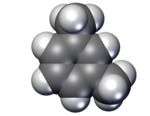| | |||
| Names | |||
|---|---|---|---|
| Preferred IUPAC name 1,3-Xylene | |||
| Systematic IUPAC name 3-Methyltoluene | |||
| Other names m-Xylene | |||
| Identifiers | |||
3D model (JSmol) | |||
| ChEBI | |||
| ChEMBL | |||
| ChemSpider | |||
| ECHA InfoCard | 100.003.252 | ||
| KEGG | |||
PubChem CID | |||
| RTECS number |
| ||
| UNII | |||
CompTox Dashboard (EPA) | |||
| |||
SMILES
| |||
| Properties | |||
Chemical formula | C8H10 | ||
| Molar mass | 106.16 g/mol | ||
| Appearance | Colorless liquid | ||
| Density | 0.86 g/mL | ||
| Melting point | −48 °C (−54 °F; 225 K) | ||
| Boiling point | 139 °C (282 °F; 412 K) | ||
| insoluble | |||
| Solubility in ethanol | miscible | ||
| Solubility in diethyl ether | miscible | ||
| Vapor pressure | 9 mmHg (20°C)[1] | ||
| -76.56·10−6 cm3/mol | |||
Refractive index (nD) | 1.49722 | ||
| Viscosity | 0.8059 cP at 0 °C 0.6200 cP at 20 °C | ||
Dipole moment | 0.33-0.37 D[2] | ||
| Hazards | |||
| Main hazards | Harmful or fatal if swallowed. Vapor harmful. Flammable liquid and vapor. | ||
| Safety data sheet | See: data page External MSDS | ||
| R-phrases (outdated) | R10 R20 R21 R38 | ||
| S-phrases (outdated) | S25 | ||
| NFPA 704 (fire diamond) | |||
| Flash point | 27 °C (81 °F; 300 K) [3] | ||
Autoignition temperature | 527 °C (981 °F; 800 K)[3] | ||
| Explosive limits | 1.1%-7.0%[1] | ||
Threshold limit value (TLV) | 100 ppm[3] (TWA), 150 ppm[3] (STEL) | ||
| Lethal dose or concentration (LD, LC): | |||
LCLo (lowest published) | 2010 ppm (mouse, 24 hr) 8000 ppm (rat, 4 hr)[4] | ||
| NIOSH (US health exposure limits): | |||
PEL (Permissible) | TWA 100 ppm (435 mg/m3)[1] | ||
REL (Recommended) | TWA 100 ppm (435 mg/m3) ST 150 ppm (655 mg/m3)[1] | ||
IDLH (Immediate danger) | 900 ppm[1] | ||
| Related compounds | |||
Related aromatic hydrocarbons | benzene toluene o-xylene p-xylene | ||
| Supplementary data page | |||
| Refractive index (n), Dielectric constant (εr), etc. | |||
Thermodynamic data | Phase behaviour solid–liquid–gas | ||
| UV, IR, NMR, MS | |||
Except where otherwise noted, data are given for materials in their standard state (at 25 °C [77 °F], 100 kPa). | |||
m-Xylene (meta-xylene) is an aromatic hydrocarbon. It is one of the three isomers of dimethylbenzene known collectively as xylenes. The m- stands for meta-, indicating that the two methyl groups in m-xylene occupy positions 1 and 3 on a benzene ring. It is in the positions of the two methyl groups, their arene substitution pattern, that it differs from the other isomers, o-xylene and p-xylene. All have the same chemical formula C6H4(CH3)2. All xylene isomers are colorless and highly flammable.[5]
Production and use
Petroleum contains about 1 weight percent xylenes.[6]
The major use of meta-xylene is in the production of isophthalic acid, which is used as a copolymerizing monomer to alter the properties of polyethylene terephthalate. The conversion m-xylene to isophthalic acid entails catalytic oxidation. meta-Xylene is also used as a raw material in the manufacture of 2,4- and 2,6-xylidine as well as a range of smaller-volume chemicals.[7][5] Ammoxidation gives isophthalonitrile.
Toxicity and exposure
Xylenes are not acutely toxic, for example the LD50 (rat, oral) is 4300 mg/kg. Effects vary with animal and xylene isomer. Concerns with xylenes focus on narcotic effects.[5]
See also
References
- ^ a b c d e NIOSH Pocket Guide to Chemical Hazards. "#0669". National Institute for Occupational Safety and Health (NIOSH).
- ^ DeanHandb, Lange´s Handbook of chemistry, 15th edition,1999.
- ^ a b c d "m-Xylene". International Chemical Safety Cards. IPCS/NIOSH. July 1, 2014. Archived from the original on December 5, 2017. Retrieved September 9, 2017.
- ^ "Xylene (o-, m-, p-isomers)". Immediately Dangerous to Life and Health Concentrations (IDLH). National Institute for Occupational Safety and Health (NIOSH).
- ^ a b c Fabri, Jörg; Graeser, Ulrich; Simo, Thomas A. (2000). "Xylenes". Ullmann's Encyclopedia of Industrial Chemistry. Weinheim: Wiley-VCH. doi:10.1002/14356007.a28_433.
- ^ EPA-454/R-93-048 Locating and estimating air emissions from sources of xylene Emission Inventory Branch Technical Support Division Office of Air Quality Planning and Standards U.S. Environmental Protection Agency March 1994
- ^ Ashford's Dictionary of Industrial Chemicals, third edition, page 9692.


